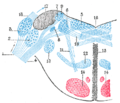Lateral vestibular nucleus: Difference between revisions
CSV import |
CSV import |
||
| Line 20: | Line 20: | ||
{{Medicine-stub}} | {{Medicine-stub}} | ||
{{No image}} | {{No image}} | ||
<gallery> | |||
File:Gray761.png|Gray's Anatomy illustration of the lateral vestibular nucleus | |||
</gallery> | |||
Revision as of 21:41, 23 February 2025
Lateral vestibular nucleus is a cluster of nerve cells (neurons) located in the vestibular system of the brain. It is one of the four major vestibular nuclei and plays a crucial role in maintaining balance and coordinating eye movements.
Anatomy
The lateral vestibular nucleus is situated in the lateral part of the pons, a region of the brainstem. It is located near the fourth ventricle and is adjacent to the medial vestibular nucleus and inferior vestibular nucleus. The neurons in the lateral vestibular nucleus receive input from the vestibular nerve, which carries sensory information from the inner ear to the brain.
Function
The primary function of the lateral vestibular nucleus is to process sensory information related to balance and spatial orientation. It receives signals from the semicircular canals and otolith organs in the inner ear, which detect changes in head position and movement. The lateral vestibular nucleus integrates this information and sends output to the spinal cord and eye muscles to coordinate balance and eye movements.
The lateral vestibular nucleus is particularly involved in maintaining upright posture. It sends signals to the extensor muscles in the limbs and trunk, helping to keep the body upright and stable. This is known as the vestibulospinal reflex.
Clinical significance
Damage or dysfunction of the lateral vestibular nucleus can lead to a range of balance and coordination problems, including vertigo, nystagmus, and ataxia. These conditions can result from various causes, such as vestibular neuritis, Meniere's disease, or stroke.

This article is a neuroanatomy stub. You can help WikiMD by expanding it!
-
Gray's Anatomy illustration of the lateral vestibular nucleus

